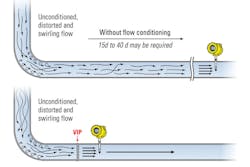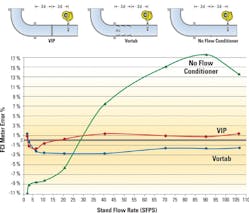When looking for a way to reduce plant operating costs, one of the potentially simplest and often least expensive solutions is to measure liquid and gas flow more accurately. Plant upgrade projects that focus on the continuous improvement of flow measurement and control can trim overall production costs by eliminating waste and reducing maintenance costs through:
- Higher product throughput and yield
- Reduced use of consumables
- Lower energy costs
- Simplified maintenance (avoiding unplanned maintenance)
- Safe operations for employees
- Environmental compliance
It all goes back to a simple truism: “You can’t control what you don’t measure.” To go one step further, add “accurately measure” to the formula for process control cost reduction.
Figure 1. Flowmeter accuracy comparison with and without flow conditioner. Flowmeter installed 6 diameters from single elbow in 4-inch (100 mm) diameter pipe.
Flow measurement analysis
The first step is to analyze the different media and flow instruments already in place, with an eye toward those affecting the costliest processes. Prioritize the search by potential cost impact (not necessarily fluid volume) to achieve the most significant return on investment.
While every process and plant are somewhat different, some common critical measurement applications are necessary for efficient operations:
- Pump protection
- Plant gases distribution
- Fluid additive/injection monitoring
- Compressed air consumption
- Boiler fuel gas and air optimization
- Tank blanketing
- Analyzer flow assurance
- Stack gas monitoring (CEMS, QAL1, MCERTS)
- Flare gas measurement
Poor measurement accuracy in these applications can be extremely expensive. The next step is to audit the efficiency of the flow instruments that are performing these critical measurements. Operators should ask a lot of questions about their plants’ flowmeters and flow switches.
Start by considering which flow measurements are most critical to efficiently process throughput and the quality of the end product. Are you primarily measuring liquids, gases or steam? Which medium is the most expensive to generate and move through the plant?
Once the most critical processes have been identified and the costs prioritized, look at the flowmeters and flow switches in place. If the plant moves liquids, gases and steam, several different flow sensing technologies may be installed.
Why is an inventory of the existing flow sensing technologies important? Many different types of flowmeter and flow switch sensing technologies exist. Some are better at liquids but do not measure steam or gas, and others are exclusively for gas. Is the best flow sensing technology in place for the media being measured?
Once the types of flowmeters and flow switches in place are determined, then ask that impolite question: How old are they? Many flow instruments are designed to operate for decades, but that does not mean a newer technology will not perform more accurately or consistently. Is it worth the expense to replace older flow instruments with newer technology devices?
Another question to ask: Are flow measurement instruments installed everywhere they are needed to optimize plant process control? To optimize a process, sometimes multiple points of measurement are helpful to compare or confirm accurate flow rates or total flows.
Before making decisions about upgrading flow instruments, operators should think about implementing flow conditioners to enhance existing flow instruments. Improving the flow measurement’s accuracy in the process control loop does not always require a new flowmeter or flow switch.
An alternative solution
One of the leading causes of inaccurate flow measurement is asymmetrical or distorted flow conditions in the upstream and downstream pipe runs from the flowmeter or flow switch. Commonly known as swirl in the pipe (see Figure 2), this condition in the flow stream “confuses” many flow sensors because their accuracy depends on a steady-state uniform flow regime.
For example, several popular flowmeters – including differential pressure, magnetic, ultrasonic and turbine – feature sensing technologies that can be significantly affected by swirl and asymmetrical flow conditions inside the pipe. Depending on the technology, these meter sensing technologies require a minimum of six to 10 upstream and up to five downstream straight pipe diameters for accurate measurement.
Unfortunately, most process industry plants are rich with bulky equipment and other real estate that make installing the required pipe straight runs required for accurate flow measurement difficult. Often, plant upgrades and retrofits require adding more flowmeters in locations that are difficult to accommodate without flow conditioning devices because of their straight-run pipe requirements.
Flow conditioners
Flow conditioners reduce straight pipe diameter requirements and can correct the flow profile distortions caused by upstream flow disturbances. These unpredictable flow profile variations are neutralized by a well-designed flow conditioner, which creates a consistent and predictable outlet flow profile to the flowmeter, resulting in accurate and repeatable flow measurements.
Flow conditioner designs include: honeycomb vanes, perforated plates, tabs, tube bundles and vanes. They all have their advantages and disadvantages, depending on many factors including the viscosity of the process media, the metering technology, pipe layout and cost requirements.
The process requirements, especially the viscosity of the process media, will likely shorten the list of potential candidates when selecting a flow conditioner. For example, some technologies are prone to clogging in slurries and/or contaminant buildup in dirty gas processes.
Figure 3. Flow conditioner designs
Some flow conditioners (see Figure 3) with a tab-type design offer extremely low pressure drop, providing significant energy cost savings when compared with other flow conditioning technologies. They help maximize obtainable plant product throughput.
Four different designs can accommodate many process requirements:
- The insertion sleeve style is the most cost-effective version. It can be installed directly into existing pipe or specially designed to meet unique piping configurations.
- The meter-run style tab flow conditioner offers a complete, simple pipe section replacement for new and existing piping systems. It is a seven-pipe diameter-long spool piece comprised of three-pipe diameters of flow conditioning internals and a built-in downstream settling chamber.
- The short-run style tab-type flow conditioner offers a simple flow conditioning pipe section replacement for new and existing piping systems. It is a three-pipe diameter long flow conditioning spool piece with just the tab flow conditioning internals.
- The elbow style tab-type conditioner is a 90-degree-long radius elbow. It offers a simple flow conditioning elbow replacement for new and existing piping. It can isolate irregular velocity profiles and swirl normally encountered in a single elbow, and it can isolate irregular velocity profiles entering the flow conditioner.
Success stories
At an oil and gas production field, the team needed to add new waste gas flowmeters to a flare gas unit to meet environmental requirements. The existing piping layout could not accommodate flowmeters. Adding a tab-type, meter-run flow conditioner to the meter assembly eliminated the required straight run for accurate measurement.
At a cramped wastewater treatment plant with a large expansion project, new air flowmeters were required in the aeration process for efficient and cost-effective air pumping into the treatment ponds. A tab-type, meter-run flow conditioner saved valuable plant real estate, reduced the piping costs and allowed room for additional equipment.
An offshore oil pumping station required a new pump to increase capacity. It had capacity for the pump’s required straight run and no way to expand the platform to accommodate the newly identified piping requirements. Placing a tab-type, elbow conditioner in the elbow solved the space problem with large cost reductions and freed up real estate for other uses.
Conclusion
When looking for ways to decrease process costs, enhancing the flow instrumentation accuracy may be a solution. This does not always mean purchasing a new flowmeter or a new switch, though that may be the best solution. Can the same results be achieved by adding a flow conditioner instead? If a new flow instrument must be purchased, can a flow conditioner reduce the required installation space, piping and total installed cost?
Don Lundberg is a senior technical staff member at The Vortab Company. Visit vortab.com for more information.




